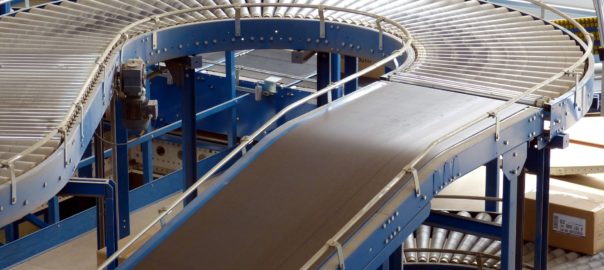Conveyor belts are an essential tool in the material handling sector. They are strips of continuous movement that are used to transport different materials from one place to another. It is mainly used to transport large quantities of material in a short time. Conveyor belts are also called belts conveyor.
Industrial conveyor belt systems.
Industrial conveyor belt systems consist of two or more pulleys. A continuous transport flow circuit of the conveyor belt revolves around the conveyor belt. To move the belt and the material to transport one or both pulleys, it must be fed.
These belts are usually made of rubber, PVC, urethane, neoprene, nylon, polyester, leather, etc. Industrial conveyor belts consist of several layers of material. Most of the material transfer belt consists of two layers. The lower layer is known as the body and gives it a linear strength and shape. The body consists of polyester, nylon and cotton. The top layer is called cover. Various rubber or plastic compounds are used to make the cover.
Conveyor belts used for industrial use:
Almost all manufacturers and suppliers rely heavily on labor before the appearance of industrial conveyor belts. Workforce safety and product quality are important issues when handling the product manually. In the current industry-driven scenarios, these pulleys and rotating belts are selected for product processing.
Today, sophisticated technology is used for industrial conveyor belts through simple conveyor belt systems. High quality belts are selected according to the specific application of the industry. For example, a simple metal belt cannot process stone, which can be a valuable or sensitive material. The material handling industry fully understands the types of conveyor belts. Depending on the application, we choose a conveyor belt system that is safer, less slow and more efficient than your requirements.
The most used industrial conveyor belts and their applications:
Solid and general-use belt:
This solid general purpose belt is commonly used in industry. It is made of rubber or fabric such as nylon, polyester, neoprene. The main use of the belt can be determined by the characteristics of the belt. When we consider the mining and milling industry, they generally use rubber belts for bulk processing of materials such as raw minerals and aggregates. In the grocery store, we use PVC conveyor belts, and at the airport, we use neoprene, polyester or rubber belts to handle your luggage.
Filter belt:-
To discharge excess liquid or toxins, the water treatment industry generally uses these filter belts to allow particles to pass through the filters instead of being transported by the conveyor system.
Woven metal belt:
These belts are mainly used in industries that deal with cooling, drying and heating processes in sectors such as food manufacturing, electronics and glass manufacturing. These belts are made of connected chains or cables to facilitate air flow while transporting the product.
Hinged Belts:
In the industry of handling several small products for scrap and recycling, this hinge strap is mainly used. This belt is made of metal. The belt provides a flat and rigid surface that rotates around the pulley through an interlocking hinge. This belt is very solid and can be used strictly.
Plastic lock belt:
These are mainly used in the food packaging industry and the automobile sector. This belt is suitable for environments where you need to clean it regularly and replace the belt. This plastic belt is the perfect replacement for cloth and metal belts.
Types of Conveyor Belts that are used in Industries:-
The main types of conveyor belts used in the industry are:
Flat conveyor belt:-
Many motorized pulleys are used to move a continuous flat belt consisting of synthetic and natural fibers such as polyester and nylon. This flat belt conveyor is the most commonly used and easily adjustable industrial conveyor system.
Modular conveyor belt:-
This type of conveyor belt consists of individual and interwoven belts, usually of hard plastic.
Conveyor belt:-
Together with the width of the belt, this belt type belt conveyor combines vertical studs.
Curved conveyor belt:-
This type of conveyor belt transports the material around the bottom edge to make the most of the floor space available with its unique curved frame feature.
Inclined or decreasing conveyor belt:-
Inclined or reduced conveyor belts are used when the material must be transported at a transport angle.
Importance of transporters in industrial automation.
Industrial automatic conveyors have a wide range of uses and uses, from manufacturing to packaging and supply.
These are the main reasons why conveyors are important in industrial automation systems.
Manual waste reduction
In the material handling industry, there are certain tasks in the process that require the transport of heavy objects on the production line. During these operations, a lot of labor is used and wasted and there is no value in the production process. There is also the potential for life and death.
To increase production in a short time, it is necessary to introduce automatic transport systems in the material handling industry. This allows people to devote their time to important business development tasks without wasting unproductive tasks.
Guarantee flexibility
Do not assume that the conveyor is inflexible and does not move. Modular conveyors are very flexible and are used for many tasks. It is also very easy to install.
Flexibility is key, so you can choose a modular transport system to customize the transport system according to your requirements and provide a better service.
Flexibility can still be achieved by installing a fixed transport system with the appropriate configuration and layout. This allows straight line flexibility, allowing this fixed transport system to transport materials from multiple production and storage locations to their final destination.
Improved Quality Control
The introduction of conveyors in industrial automation can eradicate scrap, which improves quality control. It also helps identify important problems with the product, such as defective parts and unnecessary metals. The automatic transport system allows you to configure the product for your next operation.

